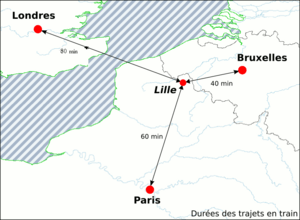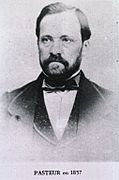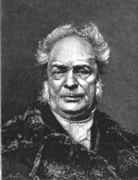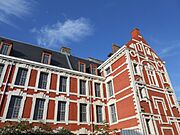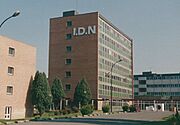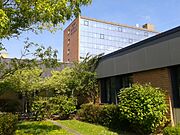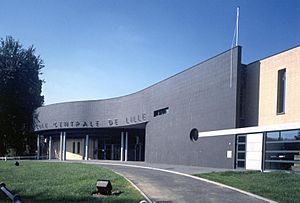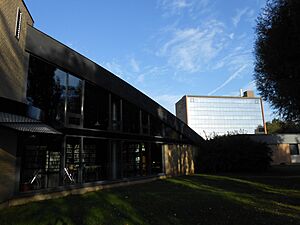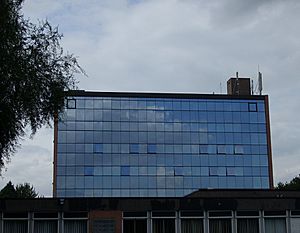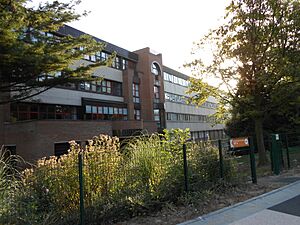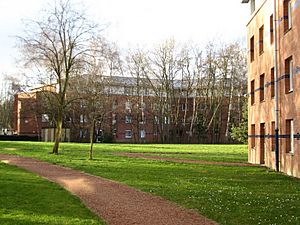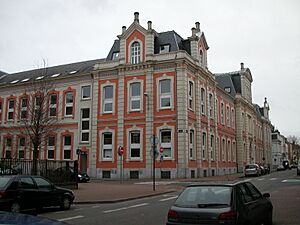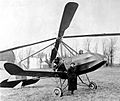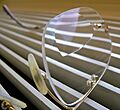École Centrale de Lille facts for kids
 |
|
| Type | Public, graduate engineering |
|---|---|
| Established | 1854-1872 |
| Students | 1300 |
| Location |
Villeneuve-d'Ascq - European Metropolis of Lille
,
50°36′23″N 3°8′11″E / 50.60639°N 3.13639°E |
| Research labs | 7 |
| Colors | Blue Orange |
| Affiliations | Centrale Graduate School Community of Universities and Institutions (COMUE) Lille Nord de France ASTech aerospace cluster I-Trans railways cluster |
École Centrale de Lille (which means "Central School of Lille") is a special engineering school in France. It helps students become engineers, which are people who design, build, and improve things using science and math. The school started a long time ago, in 1854. It is one of several "Centrale Graduate Schools" in France.
Students at this school can earn different types of degrees. These include a master's degree for engineers, called the Ingénieur Centralien de Lille. They can also study for a PhD (Doctorate), which is the highest university degree. There are also special master's degrees for specific topics. The school even offers online courses in how to manage projects.
The school teaches in both French and English. Students from many different countries come to study here. About 1,300 engineering students attend École Centrale de Lille. Many of them live in special buildings near the school. The school is part of a big science and technology campus in Villeneuve-d'Ascq, which it shares with 20,000 students from the University of Lille.
Contents
History of the School
-
Louis Pasteur, a famous scientist, was a dean at the University of Lille
École Centrale de Lille began in 1854 as the École des arts industriels et des mines de Lille. This was the same year that Louis Pasteur became a dean at the science university in Lille. He helped start new ways of doing research with industries. Other scientists, like Charles Frédéric Kuhlmann, also supported this idea.
At first, students studied for two years. By 1871, about 90 students were joining each year. To get in, students needed to have finished high school.
In 1872, the school changed its programs. Students then studied for three years. They focused on areas like civil engineering (building things), mechanical engineering (designing machines), chemistry, and manufacturing. Later, in 1892, they added courses in electrical engineering. By 1914, more than 200 students graduated each year. The school also started teaching about airplanes in 1930. In 1957, they began to focus on automatic control and computers. Over time, they added computer science, supply chain management, and micro-electronics.
Since the early 1900s, students usually get into the school through a tough exam. They often prepare for this exam in special classes after high school.
The school was first located in the center of Lille. In 1875, it moved to bigger buildings with special labs. Then, in 1968, it moved again to the modern campus of the University of Lille, where it is today.
How to Get In
Getting into the main engineering program at École Centrale de Lille usually happens after two or three years of science studies after high school. Students need to pass a special exam or be chosen through a selective process.
- Some students take a French national exam called "concours Centrale-Supelec."
- Other students come through international programs like TIME. This program allows students to study for two years at École Centrale de Lille and two years at a partner university in another country. This way, they can earn two master's degrees.
The main engineering program usually lasts three years. When students finish, they earn a master's degree. This program also makes sure students get international experience. For example, they might do internships in companies around the world. About 18% of the students at École Centrale de Lille are from other countries.
Besides the main engineering program, the school also offers other master's degrees in science and engineering. These are for students who have already finished their first university degree somewhere else. There are also special master's degrees for people who want to specialize in certain engineering or management areas. These programs are often taught in English or French.
The school is also part of a special international master's program in "Turbulence." This is a very selective two-year program. Students who complete it earn a master's degree in Fluid Dynamics and Turbulence.
Research at the School
École Centrale de Lille is part of a larger group called the European Doctoral College Lille Nord de France. This group helps about 400 students earn their PhDs each year. At École Centrale de Lille, students can earn a PhD in 7 different engineering science areas.
A PhD is a very advanced degree for people who want to do deep research. Students who want to get a PhD usually need to have a master's degree first. They can do their research in the school's labs. Some research projects are sponsored by companies.
The school has 7 main research labs. These labs welcome PhD students and visiting researchers. Here are some of the areas they study:
- Automatic Control, Computer Science and Signal Processing: This involves how computers control systems and process information.
- Mechanical engineering, fluid mechanics & civil engineering: This is about designing machines, how liquids and gases move, and building structures.
- Electrical Engineering and Power Electronics: This focuses on electricity and electronic devices.
- Electronics, Microelectronics, Nano-technologies: This looks at very tiny electronic parts and new technologies.
- Chemical engineering, Catalysis and Solid Chemistry: This involves how chemicals react and the study of solid materials.
- Systems Engineering & Manufacturing: This is about designing and managing complex systems and how things are made.
- Materials Science & Processing: This studies different materials and how to work with them.
Famous Graduates
Many talented people have graduated from École Centrale de Lille. The alumni association helps support the school and its graduates. It also organizes events and helps raise money for the school's foundation.
-
Louis Dollo (1877), a paleontologist who studied dinosaurs like the Iguanodon
Important Teachers
Many important scientists and thinkers have taught at École Centrale de Lille. Here are a few:
- Claude Auguste Lamy: A chemist who taught from 1854 to 1865. He discovered the chemical element thallium.
- Joseph Valentin Boussinesq: A mathematician and physicist who taught from 1872 to 1886. He is known for his work in how fluids move.
- Alfred Mathieu Giard: A physicist who taught from 1872 to 1882. He worked in bio-engineering.
- Bernard Brunhes: A physicist who taught electrical engineering. He discovered that the Earth's magnetic field can flip directions.
- Henri Padé: A mathematician who taught from 1897 to 1902. He is known for his work on mathematical approximations.
- Albert Châtelet: A scientist and politician who taught from 1913 to 1921.
See also
 In Spanish: École centrale de Lille para niños
In Spanish: École centrale de Lille para niños


